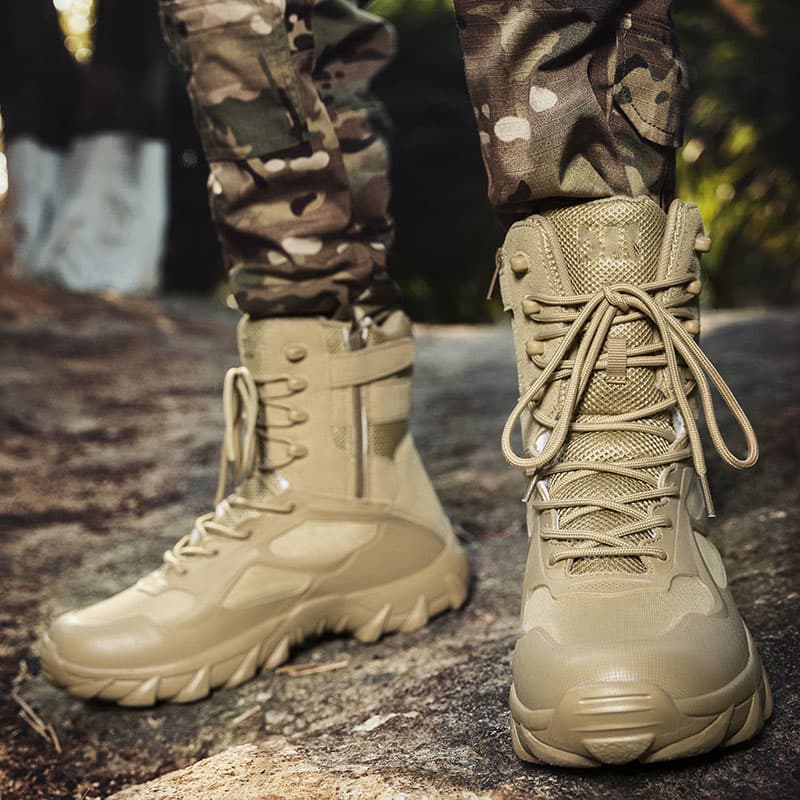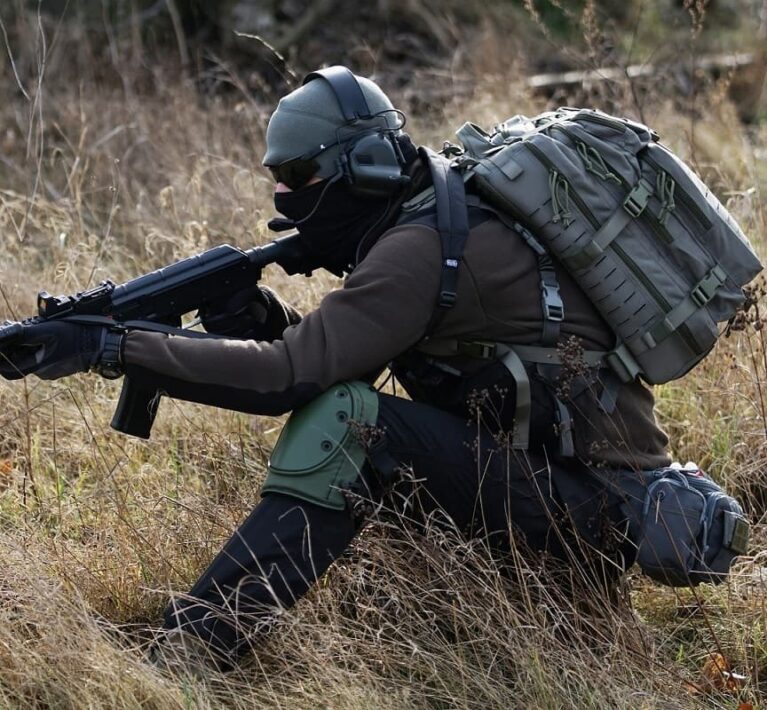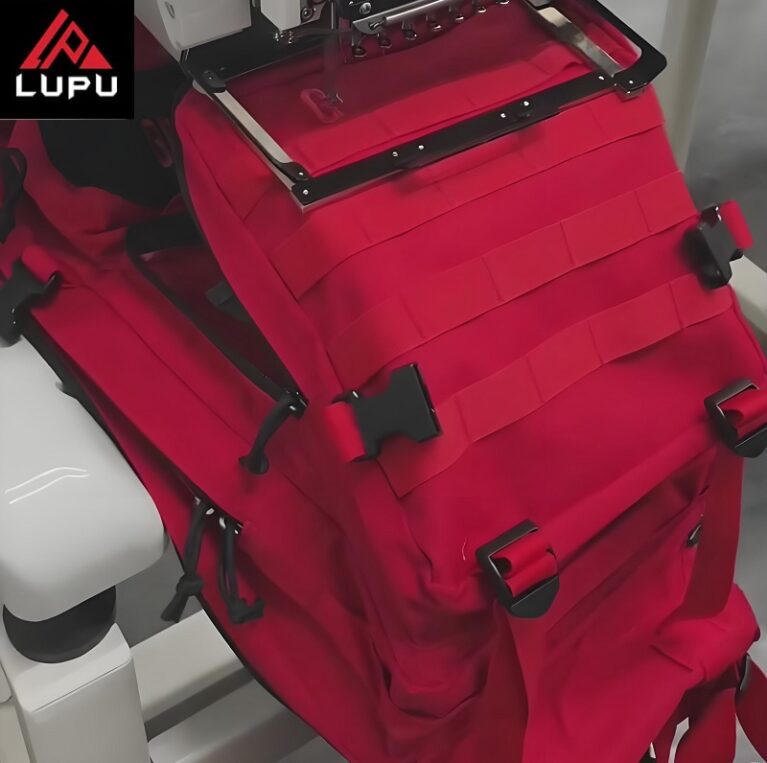Combat boots vs. tactical boots are both specialized footwear designed for specific, high-intensity activities, such as military operations, law enforcement, outdoor adventures, and survival situations. While these two types of boots may appear similar at first glance, there are distinct differences in their design, materials, functionality, and target audience. This article will delve into the core differences between combat boots vs. tactical boots, exploring aspects like materials, design, manufacturing, purpose, applicable scenarios, market trends, and more.
In the modern world, whether you're a military personnel, a law enforcement officer, an outdoor enthusiast, or someone seeking high-performance footwear, understanding the difference between these two types of boots is crucial.

What are Combat Boots?
Combat boots are military-grade boots traditionally worn by soldiers during combat situations. These boots are specifically designed to provide optimal protection, support, and durability in various combat environments. Over the years, the design and materials of combat boots have evolved to keep up with changing military needs and modern warfare demands.
Historically, combat boots were made with heavy-duty leather and reinforced soles, offering essential protection against rough terrains, extreme weather, and long periods of use. Their primary function was to ensure the wearer's safety and comfort in high-risk environments.
Key Features of Combat Boots:
Heavy-duty materials:
Combat boots often use full-grain leather or a combination of leather and canvas for rugged durability.
High ankle support:
To protect soldiers from ankle injuries during intense movements.
Steel-toed protection:
Many combat boots include steel or composite toe caps for added protection against heavy objects or impacts.
Thick soles with deep tread patterns:
These offer better traction in challenging outdoor conditions, from rocky landscapes to muddy terrains.
Insulation and weatherproofing:
Combat boots are often insulated for cold conditions and are designed to be water-resistant or waterproof.

What are Tactical Boots?
Tactical boots are a more specialized variant of combat boots, tailored to meet the needs of military personnel, law enforcement officers, and outdoor adventurers. Tactical boots are engineered for versatility, lightness, and performance across a wide variety of conditions. They are designed for professionals who need to move quickly, remain agile, and perform in high-stakes environments.
While combat boots are traditionally designed for prolonged heavy-duty use in combat zones, tactical boots are meant for rapid-response situations where mobility, comfort, and durability are prioritized. These boots are typically lighter than combat boots and have a more flexible design to support various tactical operations.
Key Features of Tactical Boots:
Lightweight construction:
Tactical boots prioritize agility and flexibility, so they are often made from synthetic materials and lightweight leather or mesh.
Enhanced breathability:
Tactical boots often feature mesh panels or ventilated linings to improve airflow and reduce heat buildup during physical exertion.
Speed lacing system:
Designed for quick wear and removal, tactical boots come equipped with advanced lacing systems, such as rapid lacing or hook-and-loop designs.
Multi-terrain soles:
Tactical boots usually have a sole that provides excellent traction across diverse environments, from urban streets to rugged trails.
Comfort and flexibility:
With padded collars, cushioned insoles, and ergonomic designs, tactical boots are built for comfort over extended periods of use.
A Brief History: Combat Boots VS. Tactical Boots
A Brief History of Combat Boots
The history of combat boots dates back to ancient civilizations, where warriors would wear sturdy footwear to protect their feet during battle. The Roman legionary sandals and medieval knight's boots were early forms of combat footwear, designed for protection and ease of movement. However, modern combat boots as we know them today emerged during World War I, with the introduction of the Trench Boot, a high-top boot designed for protection against the wet, muddy conditions of trench warfare.
By World War II, combat boots had evolved to include more durable materials like leather and rubber, becoming standard issue for soldiers in various armies. Over time, the design continued to improve to accommodate the needs of soldiers, with modern versions featuring more flexible materials, advanced soles, and additional weatherproofing.
A Brief History of Tactical Boots
In contrast, tactical boots are a more recent invention, emerging with the increased use of specialized forces such as SWAT teams and special operations groups in the late 20th century. With the rise of counter-terrorism operations and the need for mobility and flexibility, tactical boots were developed to offer better speed, comfort, and adaptability than traditional combat boots.
Differences Between Tactical Boots vs. Combat Boots
Now we will explore and analyze the core differences between combat boots vs. tactical boots from aspects such as materials, design, manufacturing, usage, applicable scenarios, and market trends.
Materials: Combat Boots vs. Tactical Boots
Both combat boots vs. tactical boots are built to withstand extreme conditions, but the materials used in their construction differ slightly due to their intended purposes.
Combat Boots Materials:
Full-grain leather is the primary material used for combat boots, offering durability, water resistance, and protection.
Nylon and canvas are often mixed with leather for added strength and flexibility.
Rubber soles with deep treads are typically used for better traction in harsh environments.
Tactical Boots Materials:
Synthetic fabrics like nylon and polyester are commonly used in tactical boots for their lightweight properties.
Suede or nubuck leather is often incorporated for a more breathable design without compromising durability.
Mesh is used to enhance airflow, helping to reduce heat buildup during intense activities.
Vibram soles are often used for superior traction and versatility.
Design: Combat Boots vs. Tactical Boots
The design of combat boots is heavily focused on stability, protection, and durability. These boots are generally heavier, bulkier, and more rigid due to the need for prolonged protection during combat situations. Their high-ankle design ensures that soldiers' feet and legs are protected from injury in intense battle zones.
Tactical boots, on the other hand, are often lighter, more flexible, and streamlined, enabling better mobility and agility. These boots are designed for professionals who need to perform quickly and efficiently in diverse environments, whether they are running, climbing, or walking for extended periods.
Usage and Application: Combat Boots vs. Tactical Boots
Combat Boots Use:
Military Operations:
Primarily used by military personnel for combat situations where protection and durability are essential.
Rugged Terrains:
Combat boots are ideal for challenging environments like jungles, deserts, and mountains.
Long-Term Use:
Designed for long-term use in situations where soldiers are stationed for extended periods in adverse conditions.
Tactical Boots Use:
Law Enforcement and Security:
Tactical boots are commonly worn by police officers, SWAT teams, and security personnel who need to move quickly and efficiently.
Outdoor Adventures:
Hikers, campers, and outdoor enthusiasts prefer tactical boots for their comfort, breathability, and agility in diverse terrains.
Emergency Response:
Tactical boots are often used by first responders and military personnel for rapid-response situations, such as rescue missions and urban operations.
Market Trends and Popularity: Combat Boots vs. Tactical Boots
In recent years, the tactical boots market has been experiencing growth due to the increasing demand from military, law enforcement, and adventure enthusiasts. The popularity of tactical boots is also fueled by the increasing demand for multifunctional, high-performance footwear that offers both comfort and durability. The tactical boots market size has expanded significantly as the need for flexible, specialized footwear has increased globally.
On the other hand, while combat boots remain essential for military personnel, their popularity has become more niche, largely restricted to military, defense, and specialized sectors. With the rise of versatile tactical footwear, many military personnel now also opt for tactical boots during certain operations, especially those that require quick movement and flexibility.
Trends in Tactical Boots:
Customization: More customers are turning to tactical boots custom options to meet specific needs. Tactical boots manufacturers are increasingly offering personalized designs, colors, and features to cater to specific needs and preferences.
Bulk Purchasing: Many organizations, including military units and law enforcement agencies, purchase tactical boots in bulk for their personnel, resulting in high demand for tactical boots wholesale and tactical boots supplier services.
Eco-Friendly Materials: There is a growing trend of incorporating sustainable materials into tactical boot designs, catering to consumers who prefer eco-conscious products.
Manufacturers and Suppliers: Tactical Boots Factory vs. Combat Boots Manufacturers
When looking for high-quality boots, both tactical boots manufacturers and combat boots companies play a critical role in supplying the right footwear for specialized needs.
Tactical boots suppliers are often specialized in creating lighter, more versatile boots that can withstand a variety of terrains and conditions. These suppliers often offer both bulk purchases and customized tactical boots to meet specific operational requirements.
Combat boots manufacturers, on the other hand, focus on producing boots with maximum durability and protection, suitable for long-term military use. These manufacturers prioritize heavy-duty materials like full-grain leather and reinforced soles.
Many manufacturers today also focus on producing tactical boots bulk, offering large orders to military units, law enforcement agencies, and security firms.
Conclusion
While both combat boots vs. tactical boots are designed for rugged, high-performance use, their differences lie in their construction, intended use, and design. Combat boots are traditionally designed for durability and protection in combat zones, while tactical boots are built for agility, comfort, and versatility across a wide range of environments.
The choice between combat boots vs. tactical boots ultimately depends on the specific needs of the wearer—whether it's long-term use in a combat zone or rapid-response mobility in various operational situations. The growth of the tactical boots market reflects the increasing demand for footwear that combines durability, comfort, and performance, making these boots essential in today's fast-paced and dynamic environments. Whether you are looking for tactical boots wholesale or custom tactical boots, selecting the right manufacturer and supplier is key to ensuring high-quality, reliable footwear for your needs.
For those in search of the ideal tactical or combat boots, it's essential to work with a reputable tactical boots company that can provide tailored solutions for specific operational demands.
Now more and more Tactical Gear brands and suppliers are cooperating with Chinese Tactical Gear Factory to gain greater benefits. For example, LUPU - is an over 25+ years Professional and trustworthy military gear manufacturer in China, who can supply to the tactical backpack, Military Combat Boots, tactical vest, tactical helmet, tactical gloves and tactical belts, and can also accept tactical gear OEM and ODM services.
Now contact LUPU Tactical Gear Factory expert team (Email: info@luputacticalgear.com) for bulk orders, custom design services, or professional guidance in selecting the right military gear solution for your customers.
Related:
Top 15 Tactical Gear Trade Shows And Exhibitions






